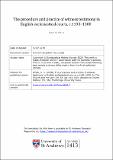The procedure and practice of witness testimony in English ecclesiastical courts, c.1193–1300
Abstract
In the twelfth century, the English church courts made considerable use of compurgation and of sworn members of the community to aid in the resolution of disputes, but by the end of the thirteenth century, academic canon law depended almost entirely on witness testimony. Romano-canonical proceduralists established rules for examining witnesses, rejecting testimonies and resolving conflicts. However, these academic ideals were not always possible or even desirable in practice. Although Roman procedure required witnesses to be eyewitnesses, English ecclesiastical practice allowed witnesses to testify to public knowledge. Furthermore, individuals who were not qualified to testify did so regardless, and their testimonies were not excluded even following exceptions. This is not to say that standard procedure was not followed; more often than not, it was. However, these differences between theory and practice indicate that practitioners (and perhaps judges) in the English ecclesiastical courts were experimenting with ways to use witness testimony beyond the confines of the academic law.
Citation
White , S B 2020 , The procedure and practice of witness testimony in English ecclesiastical courts, c.1193–1300 . in R McKitterick , C Methuen & A Spicer (eds) , The Church and the Law . vol. 56 , Studies in Church History , vol. 56 , Cambridge University Press , pp. 114-130 . https://doi.org/10.1017/stc.2019.7
Publication
The Church and the Law
ISSN
0424-2084Type
Book item
Description
The project CLCLCL has received funding from the European Research Council (ERC) under the European Union’s Horizon 2020 research and innovation programme (grant agreement No. 740611)Collections
Items in the St Andrews Research Repository are protected by copyright, with all rights reserved, unless otherwise indicated.

